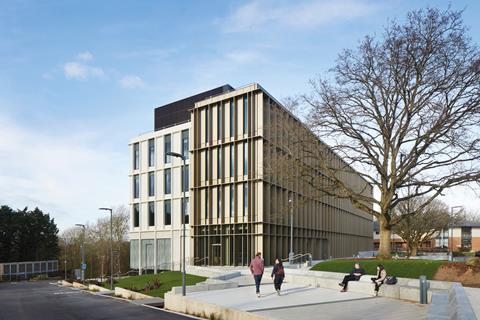- ºÃÉ«ÏÈÉúTV

All the latest updates on building safety reformRegulations latest
- Focus
- Comment
- Programmes
- CPD
- ºÃÉ«ÏÈÉúTV the Future
- Data

2024 events calendar

ºÃÉ«ÏÈÉúTV Awards
Keep up to date
- ºÃÉ«ÏÈÉúTV Boardroom
A lab of two halves … Warwick’s bold bid to keep those nasty bugs at bay

Designed by Hawkins\Brown, Warwick university’s new £54.3m interdisciplinary biomedical research facility features contrasting facades of dark bronze and white concrete that reflect the two different aspects of what is happening inside

The pandemic has changed our notion of a superhero from a crime-busting catsuit-clad hulk to an academic in a lab coat armed with a microscope. Infectious disease research is the new rock and roll, because covid-19 has made us all too aware that micro-organisms have the potential to wreak far more havoc than criminals.
There are an untold number of viruses in the wild that could jump from animals to humans and mutate into killer diseases. Our primary line of defence against lethal bacteria – antibiotics – is being weakened by their routine use for fattening cattle, to name one of many abuses.
The life sciences sector was already booming before the pandemic; covid-19 has turbo-charged it. The need for high-quality research facilities to attract top scientists and allow them to do their best work has never been more critical.
Happily for the University of Warwick, it had just procured a new biomedical research building before the pandemic struck. The Interdisciplinary Biomedical Research ºÃÉ«ÏÈÉúTV (IBBR) brings the previously separate schools of life sciences and medicine together into a new, collaborative work environment with the ambition that increased interaction will spark innovation.
…
This is PREMIUM content, available to subscribers only
You are not currently logged in. Subscribers may LOGIN here.
to access this story

A subscription will provide access to the latest industry news, expert analysis & comment from industry leaders, data and research - including our popular annual league tables. You will receive:
- Print/digital issues delivered to your door/inbox
- Unlimited access to building.co.uk including our archive
- Print/digital supplements
- ºÃÉ«ÏÈÉúTVletters - unlimited access to the stories behind the headlines
now
Get access to premium content
















